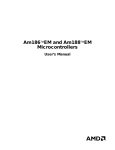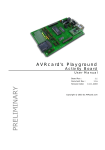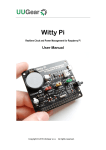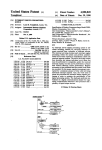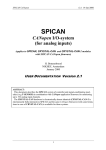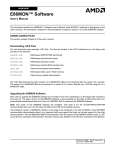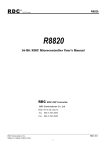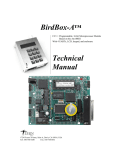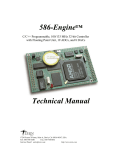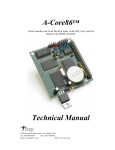Download "user manual"
Transcript
RL™ 16-bit Controller with 16-bit SRAM & Flash, 100 Base-T Ethernet, Opto-couplers, RS232/485/422 and 2GB CompactFlash Interface, Based on the 40MHz Am186ER or 80MHz RDC R1100 Technical Manual 1724 Picasso Avenue, Davis, CA 95616-0547, USA Tel: 530-758-0180 Fax: 530-758-0181 Email: [email protected] http://www.tern.com COPYRIGHT R-Engine, RL, A-Engine, A-Core86, A-Core, i386-Engine, MemCard-A, MotionC, and ACTF are trademarks of TERN, Inc. Am186ER is a trademark of Advanced Micro Devices, Inc. Paradigm C/C++ is a trademark of Paradigm Systems. Windows95/98/2000/NT/ME/XP are trademarks of Microsoft Corporation. Version 1.1 June 3, 2004 No part of this document may be copied or reproduced in any form or by any means without the prior written consent of TERN, Inc. © 2002 1724 Picasso Avenue, Davis, CA 95616-0547, USA Tel: 530-758-0180 Fax: 530-758-0181 Email: [email protected] http://www.tern.com Important Notice TERN is developing complex, high technology integration systems. These systems are integrated with software and hardware that are not 100% defect free. TERN products are not designed, intended, authorized, or warranted to be suitable for use in life-support applications, devices, or systems, or in other critical applications. TERN and the Buyer agree that TERN will not be liable for incidental or consequential damages arising from the use of TERN products. It is the Buyer's responsibility to protect life and property against incidental failure. TERN reserves the right to make changes and improvements to its products without providing notice. RL Chapter 1: Introduction Chapter 1: Introduction 1.1 Technical Manual Organization This technical manual will require special organization to accommodate the possibility of configuring the RL with two different CPUs. The CPUs are very similar, yet they do have a few differences. For purposes of organization, it will be assumed that throughout this technical manual, all information given is accurate for both CPUs, unless otherwise stated. In general, it will be written referring to the Am186ER, but will implicitly apply to the R1100. When information may deviate between CPUs, it will be explicitly shown. 1.2 Functional Description The RL™ is a controller designed for industrial machine control applications. This industrial embedded controller integrates 20 isolated opto-coupler inputs, 35 solenoid drivers, 100 Base-T Ethernet connection, 5 RS232/485/422 serial ports, and CompactFlash mass data storage support on a single PCB. It is ideal for industrial process control, high speed LAN, or remote communication machine control applications. The RL utilizes a high performance C/C++ programmable 186-generation CPU (80MHz R1100 or 40 MHz AM186ER) with a 16-bit external data bus, supporting fast code execution. It has 256KW 16-bit Flash and 256KW 16-bit battery-backed SRAM. Three CPU internal timer/counters can be used to count or time external events, or to generate non-repetitive or variable duty-cycle waveforms as PWM outputs. A realtime clock (DS1337, Dallas) provides clock/calendar with two time-of-day alarms. A 50-pin CompactFlash receptacle allows access to mass storage CompactFlash cards (up to 2 GB). TERN C/C++ programmable software packages with FAT16 file system libraries are available. An i2Chip™ Fast Ethernet Module can be installed to provide 100M Base-T network connectivity, allowing the RL to work with high-bandwidth modern Ethernet networks. This Module implements TCP/IP, UDP, ICMP and ARP with a combination of hardware/software. It has 16KB internal transmit and receiving buffer which is mapped into host processor’s direct memory. The host can access the buffer via high speed DMA transfers. The hardware Ethernet module releases internet connectivity and protocol processing from the host processor. It supports 4 independent stack connections simultaneously at a 4Mbps protocol processing speed. An RJ45 8-pin connector is on-board for connecting to 10/100 Base-T Ethernet network. Five RS232 serial ports are onboard. The CPU’s internal UART is used for remote debugging, but is also available for user application. Two Dual UARTs (SC26C92) provide 4 more UARTs. All UARTs have deep FIFOs to minimize receiver overrun and to reduce interrupt overhead. One RS232 port can be converted to RS485, or RS422. Five power Darlington array chips (ULN2003A) are installed in five DIP sockets, providing a total of 35 high voltage sinking drivers. Each driver is capable of sinking 350 mA at 50V per line. They can directly drive solenoids, relays, or lights. In place of the ULN2003As, resistor packs or DAC chips (with modification) can be optionally installed to provide TTL I/O or up to 10 analog outputs. A total of 20 opto-couplers are on-board to provide isolation for high voltage inputs. Furthermore, some control applications need to trigger an event under combined conditions of several sensors/switches. As a result, four of the 20 opto-couplers are routed to an on-board PAL, allowing flexible hardware-configurable input logic to trigger interrupts. An additional 20 TTL I/O lines are available on the J2 pin header, including bidirectional I/Os from the PPI (82C55) and multifunctional CPU internal PIOs. 1-1 Chapter 1: Introduction RL Optional high efficient Switching Regulator (LM2575) provides an external control pin to shutdown 5V and enter µA standby mode, waking-up on an active-low signal. The RL requires 8.5V to 12V DC power supply with default linear regulator, or up to 30V DC power input with switching regulator without generating excessive heat. 1.3 Features • Dimensions: 4.9 x 3.5 x 0.3 inches • Temperature: -40°C to +80°C • 40 MHz, 16-bit CPU (Am186ER), Intel 80x86 compatible, OR • 80 MHz, 16-bit CPU (R1100) • 32KB internal RAM, Am186ER ONLY • Easy to program in C/C++ • Power consumption: 200 mA at 5V • Standby mode: 50µA • Power input: + 9V to +12V unregulated DC with default linear regulator + 9V to +30V unregulated DC with optional switching regulator • Up to 256 KW 16-bit SRAM, 256 KW 16-bit Flash • Up to 2GB CompactFlash with FAT16 File system support • Flexible hardware-configurable input logic • Hardware TCP/IP stack for 100 Base-T Ethernet • Suitable for protected industrial control applications • 35 Solenoid Drivers, 20 Opto-coupler inputs • 16-bit external data bus expansion port • 5 serial ports (1 from Am186ER, four from 2 SCC2692) support full-duplex 7, 8 or 9-bit asynchronous communication (only SCC2692 supports 9-bit) • 2 high-speed PWM outputs • 6 external interrupt inputs, 3 16-bit timer/counters • 32 multifunctional I/O lines from Am186ER • 24 bi-directional I/O lines from 82C55 PPI • 512-byte serial EEPROM • Supervisor chip (691) for reset and watchdog • Real-time clock (DS1337), lithium coin battery 1-2 RL Chapter 1: Introduction 1.4 Physical Description The physical layout of the RL is shown in Figure 1.1. Switching Regulator SCC2692 Dual UART Step 2 Jumper J2 pins 38 & 40 +3.3V Regulator J2 Header Interrupts PIOs SER0 (debug port) 50-pin CF socket +12V Input Ground 100 Base-T Ethernet port 20 Optoisolated inputs J3 Header Opto-isolators J4 Header HV I/O PPI 24 bi-directional TTL level I/Os Figure 1.1 Physical layout of the RL 1-3 Chapter 1: Introduction RL Power On or Reset Step 2 jumper set? YES NO STEP 1 ACTF menu sent out through ser0 at 19200 baud STEP 2 Go to Application Code CS:IP CS:IP in EEPROM: 0x10=CS high byte 0x11=CS low byte 0x12=IP high byte 0x13=IP low byte Figure 1.2 Flow chart for ACTF operation The “ACTF boot loader” resides in the top protected sector of the 256KW on-board Flash chip (29F400). At power-on or RESET, the “ACTF” will check the STEP 2 jumper. If STEP 2 jumper is not installed, the ACTF menu will be sent out from serial port0 at 19200 baud. If STEP 2 jumper is installed, the “jump address” located in the on-board serial EEPROM will be read out and the CPU will jump to that address. A DEBUG kernel “re40_115.hex” (re80_115.hex when using the 80MHz version) can be downloaded to a starting address of “0xFA000” of the 256KW on-board flash chip. There is no ROM socket on the RL. The user’s application program must reside in SRAM for debugging in STEP1, reside in battery-backed SRAM for the standalone field test in STEP2, and finally be programmed into Flash for a complete product. For production, the user must produce an ACTF-downloadable HEX file for the application, based on the DV-P Kit. The “STEP2” jumper (J2 pins 38-40) must be installed for every production-version board. Step 1 settings In order to communicate with the RL with Paradigm C++, the RL must meet these requirements. See next section “Prepare for Debug Mode”. By default, steps 1-3 are done at the factory. 1) RE40_115.HEX (re80_115.hex with 80MHz version) must be pre-loaded into Flash starting address 0xfa000 2) The on-board EE must have the jump address for the RE40_115.HEX with starting address of 0xfa000. 3) The STEP2 jumper must be installed on J2 pins 38-40. 4) The SRAM installed must be large enough to hold your program. For a 64 KW SRAM, the physical address is 0x00000-0x01ffff For a 256 KW SRAM, the physical address is 0x00000-0x07ffff For further information on programming the RL, refer to the Software chapter. 1-4 RL Chapter 1: Introduction 1.5 RL Programming Overview Preparing for Debug Mode 1. Connect RL to PC with RS-232 link at 19,200, N, 8, 1 2. Power on RL with step 2 jumper removed (J2.38, 40) 3. ACTF menu sent to hyper terminal 4..Type ‘D’, <enter>. Send tern\186\rom\re\l_debug.hex 5. Type ‘G04000” to run l_debug.hex 6. Send tern\86\rom\re\re40_115.hex (re80_115.hex with 80MHz version). Starts at 0xFA000 7. Type ‘GFA000’, <enter>. Set Step 2 jumper (J2.38=J2.40) 8. On-board LED blinks twice, then stays on. Step 1: Debug Mode 1. Launch Paradigm C/C++ 2. Open “rl.ide” in the tern\186\samples\rl directory 3. Run samples. 4. Use samples to build application in C/C++ 5. Single step, set breakpoints, debug code 6. Debug kernel must be running each time to download. 7. At power up, if LED does not blink twice then stay on, repeat steps 1-3 and 7-10 of above section. Step 2: Standalone Mode 1. Run standalone mode, away from PC. Application resides in battery-backed SRAM. Set CS:IP to point to application. 2. Power on RL without step 2 jumper set. 3. See menu at hyper terminal. 19,200, N, 8, 1 4. Type ‘G08000’ to jump to and execute code in SRAM 5. Set step 2 jumper, cycle power. Will execute code in SRAM at every power-up. 6. Test application. 7. Return to Step 1 as necessary Step 3: Production 1. Generate application HEX file with Paradigm C/C++ based on field tested source code. 2. Power on board with step 2 jumper removed. See menu at hyper terminal. 3. Use ‘D’ command to download l_29f40r.hex in the tern\186\rom\re directory. Will prepare flash. 4. Send application HEX file. 5. Use ‘G’ command to modify CS:IP to point to application in flash, type ‘G80000’ at menu. 6. Set step 2 jumper. 1-5 Chapter 1: Introduction RL 1.6 Minimum Requirements for RL System Development 1.6.1 Minimum Hardware Requirements • • • • PC or PC-compatible computer with serial COMx port that supports 115,200 baud RL controller PC-V25 serial cable (RS-232; DB9 connector for PC COM port and IDE 2x5 connector for controller) center negative wall transformer (+9V, 500 mA), and power jack adapter (sent with EV-P/DV-P kit) 1.6.2 Minimum Software Requirements • TERN EV-P Kit installation CD and a PC running: Windows 95/98/NT/ME/2000/XP With the EV-P Kit, you can program and debug the RL in Step One and Step Two, but you cannot run Step Three. In order to generate an application Flash file and complete a project, you will need the Development Kit (DV-P Kit). 1-6 RL Chapter 2: Installation Chapter 2: Installation 2.1 Software Installation Please refer to the Technical manual for the “C/C++ Development Kit and Evaluation Kit for TERN Embedded Microcontrollers” for information on installing software. The README.TXT file on the TERN EV-P/DV-P CD-ROM contains important information about the installation and evaluation of TERN controllers. 2.2 Hardware Installation Overview • Connect Debug-serial cable: For debugging (STEP 1), place IDE connector on SER0 with red edge of cable at pin 1 • Connect wall transformer: Connect 9V wall transformer to power and plug into power jack adapter, which installs into green screw terminal Hardware installation for the RL consists primarily of connecting it to your PC and to power. As mentioned above, it requires installing the debug cable onto SER0 and plugging the output of the wall transformer into the power jack adapter. The following diagram shows the RL with power applied and connected to the debug cable. 2-1 Chapter 2: Installation RL 2.2.1 Connecting the RL to power and debug cable The red edge of the serial cable should align with pin 1 of the 5x2 pin header of SER0. Pin 1 of any header can be located as the pin closest to the name of the header. In other words, the white characters printed on the PCB that identify each header indicate pin 1 of that header. To DB9 connector. Connect to COM1 of PC. Output of wall transformer Use power jack adapter supplied with EV-P kit SER0 Red edge of cable aligned with pin 1 of header With the connections shown above, the RL is ready to communicate with the PC, either through a hyper terminal or with Paradigm C/C++. 2-2 RL Chapter 3: Hardware Chapter 3: Hardware 3.1 Am186ER AND RDC R1100 The RL is compatible with two different CPUs. Both offer and support the same on-board peripherals as well as the on the CPU itself, aside from a few differences. The Am186ER, from AMD, uses times-four crystal frequency, while the R1100, from RDC, uses times-eight. The RL uses a 10MHz system clock, giving the Am186ER a CPU clock of 40MHz and the R1100 a CPU clock of 80MHz. Both CPUs operate at +3.3V, with lines +5V tolerant. The RDC 1100 supports the same 80C188 microprocessor instruction set, but uses an internal RISC core architecture. 3.2 Am186ER – Introduction The Am186ER is based on the industry-standard x86 architecture. The Am186ER controllers are higherperformance, more integrated versions of the 80C188 microprocessors. In addition, the Am186ER has new peripherals. The on-chip system interface logic can minimize total system cost. The Am186ER has one asynchronous serial port, one synchronous serial port, 32 PIOs, a watchdog timer, additional interrupt pins, DMA to and from serial ports, a 16-bit reset configuration register, and enhanced chip-select functionality. In addition, the Am186ER has 32KB of internal volatile RAM. This provides the user with access to high speed zero wait-state memory. In some instances, users can operate the RL without external SRAM, relying only on the Am186ER’s internal RAM. 3.3 RDC R1100 – Introduction The RDC 1100 is based on RISC internal architecture while still supporting the same 80C188 microprocessor instruction set. It provides faster operation than the Am186ER, allowing it to operate at up to 80MHZ, based a 10MHz system clock and times-eight crystal operation. The RDC R1100 does not offer internal RAM like the Am186ER, so external SRAM is mandatory if using the RDC R1100. 3.4 Am186ER – Features Clock Due to its integrated clock generation circuitry, the Am186ER microcontroller allows the use of a timesfour crystal frequency. The design achieves 40 MHz CPU operation, while using a 10 MHz crystal. The R1100 offers times-eight crystal frequency, achieving 80MHz operation based on a 10MHz crystal. The system CLKOUTA signal is routed to J1 pin 4, default 40 MHz. The CLKOUTB signal is not connected in the RL. CLKOUTA remains active during reset and bus hold conditions. The RL initial function ae_init(); disables CLKOUTA and CLKOUTB with clka_en(0); and clkb_en(0); You may use clka_en(1); to enable CLKOUTA=CLK=J1 pin 4. Asynchronous Serial Port The Am186ER and R1100 CPU has one asynchronous serial channel. It support the following: 3-1 Chapter 3: Hardware RL • Full-duplex operation • 7-bit, and 8-bit data transfers • Odd, even, and no parity • One or two stop bits • Error detection • Hardware flow control • DMA transfers to and from serial port (Am186ER ONLY) • Transmit and receive interrupts • Maximum baud rate of 1/16 of the CPU clock speed • Independent baud rate generators The software drivers for the asynch. serial port implement a ring-buffered DMA receiving and ringbuffered interrupt transmitting arrangement. See the sample file tern\186\samples\ae\s0_echo.c An external SCC26C92 UART is located in position U4 and U10. For more information about the external UART SCC26C92, please refer to the section in this manual on the SCC26C92. Timer Control Unit The timer/counter unit has three 16-bit programmable timers: Timer0, Timer1, and Timer2. Timer0 and Timer1 are connected to four external pins: Timer0 output = P10 = J2 pin 12 Timer0 input = P11 = J2 pin 14 Timer1 output = P1 = J2 pin 29 Timer1 input = P0 = J2 pin 20 These two timers can be used to count or time external events, or they can generate non-repetitive or variable-duty-cycle waveforms. Timer2 is not connected to any external pin. It can be used as an internal timer for real-time coding or time-delay applications. It can also prescale timer 0 and timer 1 or be used as a DMA request source. The maximum rate at which each timer can operate is 10 MHz. Timer inputs take up to six clock cycles to respond to clock or gate events. See the sample programs timer0.c and ae_cnt0.c in the \samples\ae directory. PWM outputs The Timer0 and Timer1 outputs can also be used to generate non-repetitive or variable-duty-cycle waveforms. The timer output takes up to 6 clock cycles to respond to the clock input. Thus the minimum timer output cycle is 25 ns x 6 = 150 ns. Each timer has a maximum count register that defines the maximum value the timer will reach. Both Timer0 and Timer1 have secondary maximum count registers for variable duty cycle output. Using both the primary and secondary maximum count registers lets the timer alternate between two maximum values. MAX. COUNT A MAX. COUNT B 3-2 RL Chapter 3: Hardware Power-save Mode The RL is an ideal core module for low power consumption applications. The power-save mode of the Am186ER reduces power consumption and heat dissipation, thereby extending battery life in portable systems. In power-save mode, operation of the CPU and internal peripherals continues at a slower clock frequency. When an interrupt occurs, it automatically returns to its normal operating frequency. The DS1337 on the RL has a VOFF signal routed to H1 pin 1. VOFF is controlled by the battery-backed DS1337. The VOFF signal can be programmed by software to be in tri-state or to be active low. The DS1337 can be programmed in interrupt mode to drive the VOFF pin at 1 second, 1 minute, or 1 hour intervals. With the Switching Regulator installed (optional), the user can use VOFF to release VOFF and shut down the on-board switching regulator. By default, the VOFF option is disabled by tying VOFF to Ground. The user can also use the VOFF line to control an external switching power supply that turns the power supply on/off. 3.5 Am186ER PIO lines The Am186ER has 32 pins available as user-programmable I/O lines. Each of these pins can be used as a user-programmable input or output signal, if the normal shared function is not needed. A PIO line can be configured to operate as an input or output with or without a weak pull-up or pull-down, or as an opendrain output. A pin’s behavior, either pull-up or pull-down, is pre-determined and shown in the table below. After power-on/reset, PIO pins default to various configurations. The initialization routine provided by TERN libraries reconfigures some of these pins as needed for specific on-board usage, as well. These configurations, as well as the processor-internal peripheral usage configurations, are listed below in Table 3.1. PIO Function Power-On/Reset status RL Pin No. RL Initial after ae_init(); function call P0 P1 P2 P3 P4 P5 P6 P7 P8 P9 P10 P11 P12 P13 P14 P15 P16 P17 Timer1 in Timer1 out /PCS6/A2 /PCS5/A1 DT/R /DEN/DS SRDY A17 A18 A19 Timer0 out Timer0 in DRQ0 DRQ1 /MCS0 /MCS1 /PCS0 /PCS1 Input with pull-up Input with pull-down Input with pull-up Input with pull-up Normal Normal Normal Normal Normal Normal Input with pull-down Input with pull-up Input with pull-up Input with pull-up Input with pull-up Input with pull-up Input with pull-up Input with pull-up J2 pin 20 J2 pin 29 J2 pin 27 U4 pin 39 J2 pin 38 J2 pin 30 J2 pin 35 N/A N/A J2 pin 25 J2 pin 12 J2 pin 14 J1 pin 26 J2 pin 11 JP1 pin 2 J2 pin 23 J1 pin 19 N/A Input with pull-up Input with pull-up PAL SCC2692 select Input with pull-up Step 2 Input Input A17 A18 A19 Input with pull-down Input with pull-up Output Input with pull-up Input with pull-up Input with pull-up /PCS0 /PCS1 3-3 Chapter 3: Hardware PIO Function RL Power-On/Reset status RL Pin No. RL Initial after ae_init(); function call P18 P19 P20 P21 P22 P23 P24 P25 P26 P27 P28 P29 P30 P31 /PCS2 /PCS3 SCLK SDATA SDEN0 SDEN1 /MCS2 /MCS3 UZI TxD RxD S6/CLKSEL1 INT4 INT2 Input with pull-up Input with pull-up Input with pull-up Input with pull-up Input with pull-down Input with pull-down Input with pull-up Input with pull-up Input with pull-up Input with pull-up Input with pull-up Input with pull-up Input with pull-up Input with pull-up J2 pin 13 J2 pin 31 J2 pin 5 J2 pin 3 N/A J2 pin 9 J2 pin 17 J2 pin 18 J2 pin 4 J2 pin 34 J2 pin 32 J9 pin 2 U9 pin 14 U9 pin 16 Input with pull-up Input with pull-up Input with pull-up Input with pull-up Output Input with pull-up Input with pull-up Input with pull-up Input with pull-up* TxD0 RxD0 Input with pull-up* Input with pull-up Input with pull-up * Note: P6, P26 and P29 must NOT be forced low during power-on or reset. Table 3.1 I/O pin default configuration after power-on or reset The 32 PIO lines, P0-P31, are configurable via two 16-bit registers, PIOMODE and PIODIRECTION. The settings are as follows: MODE 0 1 2 3 PIOMODE reg. 0 0 1 1 PIODIRECTION reg. 0 1 0 1 PIN FUNCTION Normal operation INPUT with pull-up/pull-down OUTPUT INPUT without pull-up/pull-down RL initialization on PIO pins in ae_init() is listed below: outport(0xff78,0xc7bc); // PIODIR1, TxD, RxD, P16=PCS0, P17=PCS1 outport(0xff76,0x2040); // PIOM1 outport(0xff72,0xec73); // PDIR0, P12=OUTPUT, P2=PCS6, P3=PCS5 outport(0xff70,0x1040); // PIOM0, P6 = INPUT, P7=A17, P8=A18 The C function in the library re_lib can be used to initialize PIO pins. void pio_init(char bit, char mode); Where bit = 0-31 and mode = 0-3, see the table above. Example: pio_init(10, 2); will set P10 as output pio_init(1, 0); will set P1 as Timer1 output void pio_wr(char bit, char dat); pio_wr(10,1); set P10 pin high, if P10 is in output mode pio_wr(10,0); set P12 pin low, if P10 is in output mode 3-4 RL Chapter 3: Hardware unsigned int pio_rd(char port); pio_rd (0); return 16-bit status of P0-P15, if corresponding pin is in input mode, pio_rd (1); return 16-bit status of P16-P31, if corresponding pin is in input mode, Some of the I/O lines are used by the RL system for on-board components (Table 3.2). We suggest that you not use these lines unless you are sure that you are not interfering with the operation of such components (i.e., if the component is not installed). Signal P2 P3 P4 P7 P8 P14 P17 P22 P27 P28 P29 /INT0 /INT3 /INT4 Pin /PCS6 /PCS5 /DT A17 A18 /MCS0 /PCS1 SDEN0 TxD RxD S6 U4.24 U10.24 JP1.2 Function Clock input for U9 PAL Chip select for U4 SC26C92 Step Two jumper Never use for application Never use for application Chip select for Ethernet module Chip Select for U18 decoder Synchronous serial interface for RTC, EEPROM TxD0 RxD0 Reserved for EEPROM, LED, RTC, and Watchdog timer U4 SC26C92 UART interrupt. U10 SC26C92 UART interrupt Interrupt for Ethernet module Table 3.2 I/O lines used for on-board components 3.6 I/O Mapped Devices I/O Space External I/O devices can use I/O mapping for access. You can access such I/O devices with inportb(port) or outportb(port,dat). These functions will transfer one byte or word of data to the specified I/O address. The external I/O space is 64K, ranging from 0x0000 to 0xffff. The default I/O access time is 15 wait states. You may use the function void io_wait(char wait) to define the I/O wait states from 0 to 15. The system clock is 100 ns for both CPUs, while the CPU clock is 25ns for the Am186ER and 12.5ns for the R1100. Details regarding this can be found in the Software chapter, and in the Am186ER User’s Manual. Slower components, such as most LCD interfaces, might find the maximum programmable wait state of 15 cycles still insufficient. Due to the high bus speed of the system, some components need to be attached to I/O pins directly. For details regarding the chip select unit, please see Chapter 5 of the Am186ER User’s Manual. The table below shows more information about I/O mapping. I/O space Select Location Usage 0x0000-0x00ff 0x0100-0x01ff 0x0200-0x02ff 0x0300-0x03ff /PCS0 /PCS1 /PCS2 /PCS3 J1 pin 19=P16 U18.4 J2 pin 13=P18 J2 pin 31=P19 USER* U18 decoder USER USER 3-5 Chapter 3: Hardware 0x0400-0x04ff 0x0500-0x05ff 0x0600-0x06ff RL /PCS4 /PCS5 /PCS6 J2 pin 15=P3 U9.1 Reserved SC26C92 PAL *PCS0 may be used for other TERN peripheral boards, such as UR8, P100, etc. To illustrate how to interface the RL with external I/O boards, a simple decoding circuit for interfacing to an 82C55 parallel I/O chip is shown in Figure 3.1. 82C55 74HC138 RST P00-P07 Y0 15 NC A5 1 A A0 Y1 14 /SEL20 A6 2 A1 B Y2 13 /SEL40 A7 3 C Y3 12 /SEL60 P10-P17 /SEL20 /CS Y4 11 /SEL80 /WR /WR Y5 10 /SELA0 G2A 4 /PCS0 Y6 9 /SELC0 G2B 5 /RD /RD VCC 6 Y7 7 /SELF0 G1 P20-P27 D0-D7 Figure 3.1 Interface the RL to external I/O devices The function ae_init() by default initializes the /PCS0 line at base I/O address starting at 0x00. You can read from the 82C55 with inportb(0x020) or write to the 82C55 with outportb(0x020,dat). The call to inportb(0x020) will activate /PCS0, as well as putting the address 0x00 over the address bus. The decoder will select the 82C55 based on address lines A5-7, and the data bus will be used to read the appropriate data from the off-board component. Programmable Peripheral Interface (82C55A) U5 PPI (82C55) is a low-power CMOS programmable parallel interface unit for use in microcomputer systems. It provides 24 I/O pins that may be individually programmed in two groups of 12 and used in three major modes of operation. In MODE 0, the two groups of 12 pins can be programmed in sets of 4 and 8 pins to be inputs or outputs. In MODE 1, each of the two groups of 12 pins can be programmed to have 8 lines of input or output. Of the 4 remaining pins, 3 are used for handshaking and interrupt control signals. MODE 2 is a strobed bidirectional bus configuration. See data sheet for details on different mode: tern_docs\parts\82c55a.pdf. 3-6 RL Chapter 3: Hardware 7 6 5 4 3 2 1 0 GROUP 1 P o rt 2 (L o w e r) P o rt 1 M ode 0 O u tp u t 1 In p u t 0 O u tp u t 1 In p u t 0 M ode 0 1 M ode 1 GROUP 2 P o rt 2 (U p p e r) P o rt 0 M ode C om m and S e le c t 0 1 0 O u tp u t 1 In p u t 0 O u tp u t 1 In p u t 00 M ode 0 01 M ode 1 1X M ode 2 B it m a n ip u la tio n M ode S e le c t Figure 3.2 Mode Select Command Word The RL maps U5, the 82C55/uPD71055, at base I/O address 0x1A0. The ports/registers are offsets of this I/O base address. The command register = 0x1A6; Port 0 = 0x1A0; Port 1 = 0x1A2; Port 2 = 0x1A4. The following code example will set all ports to output mode: outportb(0x1A6,0x80); // mode 0 output, all pins outportb(0x1A0,0x55); // Port 0, alternating high/low on pins outportb(0x1A2,0x55); // Port 1, alternating high/low on pins outportb(0x1A4,0x55); // Port 2, alternating high/low on pins To set all ports to input mode: outportb(0x1A6, 0x9b); // mode 0 input, all pins 3-7 Chapter 3: Hardware RL You can read the ports with: inportb(0x1A0); // port 0 inportb(0x1A2); // port 1 inportb(0x1A4); // port 2 This returns an 8-bit value for each port, with each bit corresponding to the appropriate line on the port, where the most significant bit refers to Ix7 and the least significant bit refers to Ix0. All PPI lines are routed to high voltage drivers at U11, U12, and U13, with the corresponding high voltage outputs routed to J4. See section on high voltage drivers for alternate configurations. I27 – I24 are routed to the J2 pin header. Real-time Clock DS1337 The DS1337 serial real-time clock is a low-power clock/calendar with two programmable time-of-day alarms and a programmable square-wave output. Address and data are transferred serially via a 2-wire, bidirectional bus. The clock/calendar provides seconds, minutes, hours, day, date, month, and year information. The data at the end of the month is automatically adjusted for months with fewer than 31 days, including corrections for leap year. The clock operates in either 24-hour or 12-hour format with AM/PM indicator. The RTC is accessed via software drivers rtc_init() and rtc_rds(). Refer to sample code in the tern\186\samples\re directory for re_rtc.c. See tern\186\samples\rl\rl.ide. It is also possible to configure the real-time clock to raise an output line attached to an external interrupt, at 1/64 second, 1 second, 1 minute, or 1 hour intervals. This can be used in a time-driven application, or the VOFF signal can be used to turn on/off the controller using an external switching power supply. UART SC26C92 Two dual UARTs (SC26C92, Phillips, U4 and U10) are installed on the RL, providing 4 UARTs. Each SC26C92 includes two independent full-duplex asynchronous receiver/transmitters, a quadruple buffered receiver data register, an interrupt control mechanism, programmable data format, selectable baud rate for the receiver and transmitter, a multi-functional and programmable 16-bit counter/timer, an on-chip crystal oscillator, and a multi-purpose input/output including RTS and CTS mechanism. A 3.6864 MHz external crystal is installed as the default crystal for the dual UARTs. By default, all UARTs are configured with RS-232 drivers. One port can be optionally configured to RS-485 or RS-422. For more detailed information, refer to the SC26C92 data sheets (Phillips Semiconductors) or on the CD in the tern_docs\parts directory. Sample programs for the SC26C92 can be found in the c:\tern\186\samples\rl directory. See tern\186\samples\rl\rl.ide. 3.7 Other Devices A number of other devices are also available on the RL. Some of these are optional, and might not be installed on the particular controller you are using. For a discussion regarding the software interface for these components, please see the Software chapter. 3-8 RL Chapter 3: Hardware On-board Supervisor with Watchdog Timer The MAX691/LTC691 (U6) is a supervisor chip. With it installed, the RL has several functions: watchdog timer, battery backup, power-on-reset delay, power-supply monitoring, and power-failure warning. These will significantly improve system reliability. Watchdog Timer The watchdog timer is activated by setting a jumper on J9 of the RL. The watchdog timer provides a means of verifying proper software execution. In the user's application program, calls to the function hitwd() (a routine that toggles the P29 = WDI pin of the MAX691) should be arranged such that the WDI pin is accessed at least once every 1.6 seconds. If the J9 jumper is on and the WDI pin is not accessed within this time-out period, the watchdog timer pulls the WDO pin low, which asserts /RESET. This automatic assertion of /RESET may recover the application program if something is wrong. After the RL is reset, the WDO remains low until a transition occurs at the WDI pin of the MAX691. When controllers are shipped from the factory the J9 jumper is off, which disables the watchdog timer. The Am186ER has an internal watchdog timer. This is disabled by default with ae_init(). Battery Backup Protection The backup battery protection protects data stored in the SRAM and RTC. The battery-switch-over circuit compares VCC to VBAT (+3 V lithium battery positive pin), and connects whichever is higher to the VRAM (power for SRAM and RTC). Thus, the SRAM and the real-time clock DS1337 are backed up. In normal use, the lithium battery should last about 3-5 years without external power being supplied. When the external power is on, the battery-switch-over circuit will select the VCC to connect to the VRAM. EEPROM A serial EEPROM of 512 bytes (24C04) is be installed in U7. The RL uses the P22 and P29 to interface with the EEPROM. The EEPROM can be used to store important data such as a node address, calibration coefficients, and configuration codes. It typically has 1,000,000 erase/write cycles. The data retention is more than 40 years. EEPROM can be read and written by simply calling the functions ee_rd() and ee_wr(). A range of lower addresses in the EEPROM is reserved for TERN use, 0x00 – 0x1F. The addresses 0x20 to 0x1FF are for user application. Opto-couplers The RL supports 20 opto-couplers in 5 PS2501-4 packages. These opto-couplers can be used for digital inputs, relay contact monitoring, or powerline monitoring. Each opto-coupler has a 3µs ON time and 5µs OFF time. The status of the opto-couplers is read via the input ports of the SC26C92s and CPU PIOs, 14 from the two SC26C92s and 2 from PIO lines. All inputs to the opto-couplers are routed to the J3 header. The user is required to provide supply voltage to the opto-couplers. The RL is shipped from the factory with the supply voltage tied to +12VI via jumper on the J3 header. The output lines of the opto-couplers (IS0-IS6, IP0-IP6, P11, and P0) are pulled high via 10K ohm resistor network making the opto-coupler OFF by default. Pulling input lines low will turn the opto-coupler ON and pull output lines low. See sample project: c:\tern\186\samples\rl\rl.ide for example program (rl_opto.c). 3-9 Chapter 3: Hardware RL High Voltage, High-current drivers The ULN2003 has high voltage, high current Darlington transistor arrays, consisting of seven silicon NPN Darlington pairs on a common monolithic substrate. There are five ULN2003s on the RL in locations U11U15, providing a total of 35 channels. All channels feature open-collector outputs for sinking 350 mA at 50V, and integral protection diodes for driving inductive loads. Peak inrush currents of up to 500 mA sinking are allowed. These outputs may be paralleled to achieve high-load capability, although each driver has a maximum continuous collector current rating of 350 mA at 50V. The maximum power dissipation allowed is 2.20 W per chip at 25 degrees C (°C). The common substrate G is tied to ground by default. For inductive loads, K (J3 pin 39) connects to the protection diodes in the ULN2003 chips and should be tied to highest voltage in the external load system. K can be connected to a user provided voltage at J3 pin 40. ULN2003 is a sinking driver, not a sourcing driver. An example of typical application wiring is shown in 0. O1 Solenoid +12V Power Supply GND/SUB ULN2003 TinyDrive K +12V GND/SUB Figure 3.3 Drive inductive loads with high voltage/current drivers. By design, the sockets at locations U11- U15 only allow sinking drivers. Sourcing drivers are not allowed. However, if TTL level I/Os are needed, the ULN2003s can be replaced by resistor pack ICs. U11 – U13 are accessed by the U5 PPI (82C55), and with resistor packs installed, can provide user programmable TTL level inputs and/or outputs. Locations U14 and U15 are accessed via the output ports of the SC26C92s, and with resistor packs installed can provide only TTL level outputs. Ethernet Module The RL supports an i2Chip W3100A which is an LSI of hardware protocol stack that provides an easy, low-cost solution for high-speed internet connectivity for digital devices by allowing simple installation of TCP/IP stack in the hardware. The i2Chip offers a quick and easy way to add Ethernet networking functionality to embedded controllers. It can completely offload internet connectivity and processing standard protocols from the host system, reducing development time and cost. It contains TCP/IP protocol stacks such as TCP, UDP, IP, ARP and ICMP protocols, as well as Ethernet protocols such as Data Link Control and MAC protocol. The full datasheet is provided on the TERN CD: \tern_docs\parts\w3100a datasheet 3.1.pdf. Also find sample programs for accessing the module in the 3-10 RL Chapter 3: Hardware RL sample project, c:\tern\186\sampels\rl\rl.ide. Sample programs include i2chip.c and i2_dma.c. The module is accessed by P14 = /MCS0 (midrange chip select). The chip select can be mapped into memory by initializing the MMCS and MPCS registers. See chapter 5 of the Am186ER technical manual (amd_docs\am186er). 3.8 Headers and Connectors Expansion Headers J1 and J2 There are two 20x2 0.1 spacing headers for RL expansion. Most signals are directly routed to the Am186ER processor. These signals are +3.3V signals, but are +5V tolerant. Any voltages above +5V will certainly damage the board. J2 Signal GND P4 TxD0 RxD0 P5 TxDA RxDA I25 P0 P25 I27 P11 P10 /INT0 /INT1 P26 GND 40 38 36 34 32 30 28 26 24 22 20 18 16 14 12 10 8 6 4 2 39 37 35 33 31 29 27 25 23 21 19 17 15 13 11 9 7 5 3 1 J1 Signal VCC P14 P6 P19 P1 P2 A19 P15 I24 P24 I26 P18 P13 P23 NMI SCLK SDAT VCC /BHE D15 /RST RST P16 D14 D13 D12 /WR /RD D11 D10 D9 D8 1 3 5 7 9 11 13 15 17 19 21 23 25 27 29 31 33 35 37 39 2 4 6 8 10 12 14 16 18 20 22 24 26 28 30 32 34 36 38 40 GND CLK GND D0 D1 D2 D3 D4 D5 D6 D7 GND P12 A7 A6 A5 A4 A3 A2 A1 Table 3.3 Signals for J2 and J1, 20x2 expansion ports 3-11 RL Chapter 4: Software Chapter 4: Software Please refer to the Technical Manual of the “C/C++ Development Kit for TERN 16-bit Embedded Microcontrollers” for details on debugging and programming tools. An IDE project for the RL has been pre-built for your convenience. It is located in the \tern\186\samples\rl directory. The filename is “rl.ide”. It includes sample code linked to the correct libraries, ready to run and access RL hardware. Guidelines, awareness, and problems in an interrupt driven environment Although the C/C++ Development Kit provides a simple, low cost solution to application engineers, some guidelines must be followed. If they are not followed, you may experience system crashes, PC hang-ups, and other problems. The debugging of interrupt handlers with the Remote Debugger can be a challenge. It is possible to debug an interrupt handler, but there is a risk of experiencing problems. Most problems occur in multi-interruptdriven situations. Because the remote kernel running on the controller is interrupt-driven, it demands interrupt services from the CPU. If an application program enables interrupt and occupies the interrupt controller for longer than the remote debugger can accept, the debugger will time-out. As a result, your PC may hang-up. In extreme cases, a power reset may be required to restart your PC. For your reference, be aware that our system is remote kernel interrupt-driven for debugging. The run-time environment on TERN controllers consists of an I/O address space and a memory address space. I/O address space ranges from 0x0000 to 0xffff, or 64 KB. Memory address space ranges from 0x00000 to 0xfffff in real-mode, or 1 MB. These are accessed differently, and not all addresses can be translated and handled correctly by hardware. I/O and memory mappings are done in software to define how translations are implemented by the hardware. Implicit accesses to I/O and memory address space occur throughout your program from TERN libraries as well as simple memory accesses to either code or global and stack data. You can, however, explicitly access any address in I/O or memory space, and you will probably need to do so in order to access processor registers and on-board peripheral components (which often reside in I/O space) or non-mapped memory. This is done with four different sets of similar functions, described below. poke/pokeb Arguments: unsigned int segment, unsigned int offset, unsigned int/unsigned char data Return value: none These standard C functions are used to place specified data at any memory space location. The segment argument is left shifted by four and added to the offset argument to indicate the 20-bit address within memory space. poke is used for writing 16 bits at a time, and pokeb is used for writing 8 bits. The process of placing data into memory space means that the appropriate address and data are placed on the address and data-bus, and any memory-space mappings in place for this particular range of memory will be used to activate appropriate chip-select lines and the corresponding hardware component responsible for handling this data. peek/peekb Arguments: unsigned int segment, unsigned int offset Return value: unsigned int/unsigned char data 4-1 Chapter 4: Software RL These functions retrieve the data for a specified address in memory space. Once again, the segment address is shifted left by four bits and added to the offset to find the 20-bit address. This address is then output over the address bus, and the hardware component mapped to that address should return either an 8-bit or 16-bit value over the data bus. If there is no component mapped to that address, this function will return random garbage values every time you try to peek into that address. outport/outportb Arguments: unsigned int address, unsigned int/unsigned char data Return value: none This function is used to place the data into the appropriate address in I/O space. It is used most often when working with processor registers that are mapped into I/O space and must be accessed using either one of these functions. This is also the function used in most cases when dealing with user-configured peripheral components. When dealing with processor registers, be sure to use the correct function. Use outport if you are dealing with a 16-bit register. inport/inportb Arguments: unsigned int address Return value: unsigned int/unsigned char data This function can be used to retrieve data from components in I/O space. You will find that most hardware options added to TERN controllers are mapped into I/O space, since memory space is valuable and is reserved for uses related to the code and data. Using I/O mappings, the address is output over the address bus, and the returned 16 or 8-bit value is the return value. For a further discussion of I/O and memory mappings, please refer to the Hardware chapter of this technical manual. 4.1 Programming Overview The ACTF loader in the RL 256KW Flash will perform the system initialization and prepare for new application code download or immediately run the pre-loaded code. A remote debugger kernel can be loaded into the Flash located starting 0xfa000. Debugging at baud rate of 115,200 (re40_115.HEX for the Am186ER and re80_115.HEX for the R1100) is available. A loader file “l_debug.hex” and both debugger files re40_115.hex and re80_115.HEX, are included in the EV-P/DV-P CD under the c:\tern\186\rom\re\ directory. A functional diagram of the ACTF (embedded in the RL) is shown below: 4-2 RL Chapter 4: Software Power on or Reset STEP2 Jumper on ? J2 pin 38=P4=GND ? Yes Read EE for the jump address CS:IP No SEND out MENU over SER0 at 19200, N, 8, 1 to Hyperterminal of Windows95/98 Text command or download new codes Process Commands See ACTF-kit and Functions for detail RUN the program starting at the CS:IP The C function prototypes supporting Am186ER hardware can be found in header file “ae.h”, in the c:\tern\186\include directory. Sample programs can be found in the c:\tern\186\samples\ae, c:\tern\186\samples\re and c:\tern\186\samples\rl directories. There is no ROM socket on the RL. The user’s application program must reside in SRAM for debugging in STEP1, reside in battery-backed SRAM for the standalone field test in STEP2, and finally be programmed into Flash for a complete product. The on-board Flash 29F400BT has 256K words of 16-bits each. It is divided into 11 sectors, comprised of one 16KB, two 8KB, one 32KB, and seven 64KB sectors. The top one 16KB sector is pre-loaded with ACTF boot strip, the one 8KB sector starting 0xfa000 is for loading remote debugger kernel, and the reset all sectors are free for application use. The top 16KB ACTF boot strip is protected. Two utility HEX files, “l_debug.HEX” and “L_29F40R.HEX”, are designed for downloading into SRAM starting at 0x04000 with ACTF-PC-HyperTerminal. Use the “D” command to download, and use the “G” command to run. “L_DEBUG.HEX” will erase the 8KB sector and load a “re40_115.HEX” or “re80_115.HEX”. “L_29F40R.HEX” will erase the remaining sectors for downloading your application HEX file. 4-3 Chapter 4: Software RL ACTF Utility 0xFFFFF 0xFC000 Flash Debug Kernel re40_115 0xFA000 0x80000 0x20000 512K SRAM 128K SRAM 0x08000 Beginning of application in STEP 1& 2 0x00000 For production, the user must produce an ACTF-downloadable HEX file for the application, based on the DV-P. The application HEX file can be loaded into the on-board Flash starting address at 0x80000 or 0xC0000. The on-board EE must be modified with a “G80000” or “GC0000” command while in the ACTF-PC-HyperTerminal Environment. The “STEP2” jumper (J2 pins 38-40) must be installed for every production-version board. All files needed to erase/write flash and debug kernels are found in the c:\tern\186\rom\re directory. Step 1 settings In order to correctly download a program in STEP1 with Paradigm C/C++, the RL must meet these requirements: 1) re40_115.hex must be pre-loaded into Flash starting address 0xfa000 (re80_115.hex for 80MHz version) 2) The SRAM installed must be large enough to hold your program. For a 128K SRAM, the physical address is 0x00000-0x01ffff For a 512K SRAM, the physical address is 0x00000-0x07ffff 3) The on-board EE must have a correct jump address for the re40_115.HEX with starting address of 0xfa000. 4) The STEP2 jumper must be installed on J2 pins 38-40. 4-4 RL Chapter 4: Software 4.2 RE.LIB RE.LIB is a C library for basic RL operations. It includes the following modules: AE.OBJ, SER0.OBJ, SER1R.OBJ, and AEEE.OBJ. You need to link RE.LIB in your applications and include the corresponding header files in your source code. The following is a list of the header files: Include-file name Description AE.H SER0.H SER1R.H AEEE.H PPI, timer/counter, RTC, Watchdog Internal serial port 0 External UART SCC26C92 on-board EEPROM 4.3 Functions in AE.OBJ 4.3.1 RL Initialization ae_init This function should be called at the beginning of every program running on RL core controllers. It provides default initialization and configuration of the various I/O pins, interrupt vectors, sets up expanded DOS I/O, and provides other processor-specific updates needed at the beginning of every program. There are certain default pin modes and interrupt settings you might wish to change. With that in mind, the basic effects of ae_init are described below. For details regarding register use, you will want to refer to the AMD Am186ER Microcontroller User’s manual. • Initialize the upper chip select to support the default ROM. The CPU registers are configured such that: − Address space for the ROM is from 0x80000-0xfffff (to map MemCard I/O window) − 512K ROM Block size operation. − Three wait state operation. For details, see the UMCS (Upper Memory Chip Select Register) reference in the processor User’s manual. outport(0xffa0, 0x80bf); // UMCS, 512K ROM, 0x80000-0xfffff • Initialize LCS (Lower Chip Select) for use with the SRAM. It is configured so that: − Address space starts 0x00000, with a maximum of 512K RAM. − Three wait state operation. Reducing this value can improve performance. − Disables PSRAM, and disables need for external ready. outport(0xffa2, 0x7fbf); // LMCS, base Mem address 0x0000 • Initialize MMCS and MPCS so that MCS0 and PCS0-PCS6 (except for PCS4) are configured so: − MCS0 is mapped also to a 256K window at 0x80000. If used with MemCard, this chip select line is used for the I/O window. − Sets up PCS5-6 lines as chip-select lines, with three wait state operation. outport(0xffa8, 0xa0bf); // s8, 3 wait states outport(0xffa6, 0x81ff); // CS0MSKH • Initialize PACS so that PCS0-PCS3 are configured so that: − Sets up PCS0-3 lines as chip-select lines, with fifteen wait state operation. − The chip select lines starts at I/O address 0x0000, with each successive chip select line addressed 0x100 higher in I/O space. 4-5 Chapter 4: Software RL outport(0xffa4, 0x007f); // CS0MSKL, 512K, enable CS0 for RAM • Configure the two PIO ports for default operation. All pins are set up as default input, except for P29 (used for driving the LED), and peripheral function pins for SER0, as well as chip selects for the PPI. outport(0xff78,0xe73c); // PDIR1, TxD0, RxD0 // P16=PCS0, P17=PCS1 outport(0xff76,0x0000); // PIOM1 outport(0xff72,0xec7b); // PDIR0, P12 Output,A18,A17,P2=PCS6 outport(0xff70,0x1000); // PIOM0, P3 = /PCS5 The chip select lines are set to 15 wait states, by default. This makes it possible to interface with many slower external peripheral components. If you require faster I/O access, you can modify this number down as needed. Some TERN components, such as the Real-Time-Clock, might fail if the wait state is decreased too dramatically. A function is provided for this purpose. void io_wait Arguments: char wait Return value: none. This function sets the current wait state depending on the argument wait. wait=0, wait=1, wait=2, wait=3, wait=4, wait=5, wait=6, wait=7, wait wait wait wait wait wait wait wait states states states states states states states states = = = = = = = = 0, I/O enable for 100 ns 1, I/O enable for 100+25 ns 2, I/O enable for 100+50 ns 3, I/O enable for 100+75 ns 5, I/O enable for 100+125 ns 7, I/O enable for 100+175 ns 9, I/O enable for 100+225 ns 15, I/O enable for 100+375 ns 4.3.2 External Interrupt Initialization There are up to six external interrupt sources on the RL, consisting of five maskable interrupt pins (INT4INT0) and one non-maskable interrupt (NMI). There are also an additional eight internal interrupt sources not connected to the external pins, consisting of three timers, two DMA channels, both asynchronous serial ports, and the NMI from the watchdog timer. For a detailed discussion involving the ICUs, the user should refer to Chapter 7 of the AMD Am186ER Microcontroller User’s Manual. Or the R1100 user’s manual, both available on the CD under the amd_docs directory. Some interrupt lines on the RL are reserved for system use. These include /INT0, INT3 and /INT4. TERN provides functions to enable/disable all of the 6 external interrupts. The user can call any of the interrupt init functions listed below for this purpose. The first argument indicates whether the particular interrupt should be enabled, and the second is a function pointer to an appropriate interrupt service routine that should be used to handle the interrupt. The TERN libraries will set up the interrupt vectors correctly for the specified external interrupt line. At the end of interrupt handlers, the appropriate in-service bit for the IR signal currently being handled must be cleared. This can be done using the Nonspecific EOI command. At initialization time, interrupt priority was placed in Fully Nested mode. This means the current highest priority interrupt will be handled first, and a higher priority interrupt will interrupt any current interrupt handlers. So, if the user chooses to clear the in-service bit for the interrupt currently being handled, the interrupt service routine just needs to issue the nonspecific EOI command to clear the current highest priority IR. To send the nonspecific EOI command, you need to write the EOI register word with 0x8000. outport(0xff22, 0x8000); 4-6 RL Chapter 4: Software void intx_init Arguments: unsigned char i, void interrupt far(* intx_isr) () ) Return value: none These functions can be used to initialize any one of the external interrupt channels (for pin locations and other physical hardware details, see the Hardware chapter). The first argument i indicates whether this particular interrupt should be enabled or disabled. The second argument is a function pointer, which will act as the interrupt service routine. The overhead on the interrupt service routine, when executed, is about 20 µs. By default, the interrupts are all disabled after initialization. To disable them again, you can repeat the call but pass in 0 as the first argument. The NMI (Non-Maskable Interrupt) is special in that it can not be masked (disabled). The default ISR will return on interrupt. void void void void void void int0_init( unsigned char i, int1_init( unsigned char i, int2_init( unsigned char i, int3_init( unsigned char i, int4_init( unsigned char i, nmi_init(void interrupt far void interrupt far(* void interrupt far(* void interrupt far(* void interrupt far(* void interrupt far(* (* nmi_isr)()); int0_isr)() int1_isr)() int2_isr)() int3_isr)() int4_isr)() ); ); ); ); ); 4.3.3 I/O Initialization Two ports of 16 I/O pins each are available on the RL. Hardware details regarding these PIO lines can be found in the Hardware chapter. Several functions are provided for access to the PIO lines. At the beginning of any application where you choose to use the PIO pins as input/output, you will probably need to initialize these pins in one of the four available modes. Before selecting pins for this purpose, make sure that the peripheral mode operation of the pin is not needed for a different use within the same application. You should also confirm the PIO usage that is described above within ae_init(). During initialization, several lines are reserved for TERN usage and you should understand that these are not available for your application. There are several PIO lines that are used for other on-board purposes. These are all described in some detail in the Hardware chapter of this technical manual. For a detailed discussion toward the I/O ports, please refer to Chapter 14 of the AMD Am186ER User’s Manual. Please see the sample program ae_pio.c in tern\186\samples\ae. You will also find that these functions are used throughout TERN sample files, as most applications do find it necessary to re-configure the PIO lines. The function pio_wr and pio_rd can be quite slow when accessing the PIO pins. Depending on the pin being used, it might require from 5-10 us. The maximum efficiency you can get from the PIO pins occur if you instead modify the PIO registers directly with an outport instruction Performance in this case will be around 1-2 us to toggle any pin. The data register is 0xff74 for PIO port 0, and 0xff7a for PIO port 1. void pio_init Arguments: Return value: char bit, char mode none bit refers to any one of the 32 PIO lines, 0-31. mode refers to one of four modes of operation. • 0, normal operation 4-7 Chapter 4: Software • • • RL 1, input with pullup/down 2, output 3, input without pull unsigned int pio_rd: Arguments: char port Return value: byte indicating PIO status Each bit of the returned 16-bit value indicates the current I/O value for the PIO pins in the selected port. void pio_wr: Arguments: Return value: char bit, char dat none Writes the passed in dat value (either 1/0) to the selected PIO. 4.3.4 Timer Units The three timers present on the RL can be used for a variety of applications. All three timers run at ¼ of the processor clock rate, which determines the maximum resolution that can be obtained. Be aware that if you enter power save mode, the timers will operate at a reduced speed as well. These timers are controlled and configured through a mode register that is specified using the software interfaces. The mode register is described in detail in chapter 10 of the AMD AM186ER User’s Manual. The timers can be used to time execution of your user-defined code by reading the timer values before and after execution of any piece of code. For a sample file demonstrating this application, see the sample file timer.c in the directory tern\186\samples\ae. Two of the timers, Timer0 and Timer1 can be used to do pulse-width modulation with a variable duty cycle. These timers contain two max counters, where the output is high until the counter counts up to maxcount A before switching and counting up to maxcount B. U12 AD7852 uses Timer1 output (P1=J2.29) as ADC clock, up to 5MHz. It is also possible to use the output of Timer2 to pre-scale one of the other timers, since 16-bit resolution at the maximum clock rate specified gives you only 150 Hz. Only by using Timer2 can you slow this down even further. The sample files timer02.c and timer12.c, located in tern\186\samples\ae, demonstrate this. The specific behavior that you might want to implement is described in detail in chapter 10 of the AMD AM186ER User’s Manual. void t0_init void t1_init Arguments: int tm, int ta, int tb, void interrupt far(*t_isr)() Return values: none Both of these timers have two maximum counters (MAXCOUNTA/B) available. These can all be specified using ta and tb. The argument tm is the value that you wish placed into the T0CON/T1CON mode registers for configuring the two timers. The interrupt service routine t_isr specified here is called whenever the full count is reached, with other behavior possible depending on the value specified for the control register. void t2_init Arguments: int tm, int ta, void interrupt far(*t_isr)() Return values: none. Timer2 behaves like the other timers, except it only has one max counter available. 4-8 RL Chapter 4: Software 4.3.5 Other library functions On-board supervisor MAX691 or LTC691 The watchdog timer offered by the MAX691 or LTC691 offers an excellent way to monitor improper program execution. If the watchdog timer (J9) jumper is set, the function hitwd() must be called every 1.6 seconds of program execution. If this is not executed because of a run-time error, such as an infinite loop or stalled interrupt service routine, a hardware reset will occur. void hitwd Arguments: none Return value: none Resets the supervisor timer for another 1.6 seconds. void led Arguments: int ledd Return value: none Turns the on-board LED on or off according to the value of ledd. Real-Time Clock The real-time clock can be used to keep track of real time. Backed up by a lithium-coin battery, the real time clock can be accessed and programmed using two interface functions. There is a common data structure used to access and use both interfaces. typedef struct{ unsigned char unsigned char unsigned char unsigned char unsigned char unsigned char unsigned char unsigned char unsigned char unsigned char unsigned char unsigned char unsigned char } TIM; sec1; One second digit. sec10; Ten second digit. min1; One minute digit. min10; Ten minute digit. hour1; One hour digit. hour10; Ten hour digit. day1; One day digit. day10; Ten day digit. mon1; One month digit. mon10; Ten month digit. year1; One year digit. year10; Ten year digit. wk; Day of the week. int rtc_rd Arguments: TIM *r Return value: int error_code This function places the current value of the real time clock within the argument r structure. The structure should be allocated by the user. This function returns 0 on success and returns 1 in case of error, such as the clock failing to respond. int rtc_rds Arguments: char* realTime Return value: int error_code 4-9 Chapter 4: Software RL This function is slightly different from the rtc_rd function. It places the current value of the real time clock into a character string instead of the TIM structure, making it a more convenient function than rtc_rd. This function places the current value of the real time clock in the char* realTime. The string has a format of “week year10 year1 month10 month1 day10 day1 hour10 hour1 min10 min1 second10 second1”. The rtc_rds function also places a null terminating character at the end of the time string. It is important to note that you must be sure to make the destination character string long enough to hold the real time clock value plus the null character. A destination character string that is too short will result in the data immediately following the character string in memory to be overwritten, causing unknown results. For example “3040503142500\0” represents Wednesday May 3, 2004 at 02:25.00 pm. There are only two positions for the year, so the user must decide how to determine the hundreds and thousands digit of the year. Here we just assume “04” correlates to the year 2004. The length of char * realTime must be at least 14 characters, 13 plus one null terminating character. This function returns 0 on success and returns 1 in case of error, such as the clock failing to respond. Void rtc_init Arguments: char* t Return value: none This function is used to initialize and set a value into the real-time clock. The argument t should be a nullterminated byte array that contains the new time value to be used. The byte array should correspond to { weekday, year10, year1, month10, month1, day10, day1, hour10, hour1, minute10, minute1, second10, second1, 0 }. If, for example, the time to be initialized into the real time clock is June 5, 1998, Friday, 13:55:30, the byte array would be initialized to: unsigned char t[14] = { 5, 9, 8, 0, 6, 0, 5, 1, 3, 5, 5, 3, 0 }; Delay In many applications it becomes useful to pause before executing any further code. There are functions provided to make this process easy. For applications that require precision timing, you should use hardware timers provided on-board for this purpose. void delay0 Arguments: unsigned int t Return value: none This function is just a simple software loop. The actual time that it waits depends on processor speed as well as interrupt latency. The code is functionally identical to: While(t) { t--; } Passing in a t value of 600 causes a delay of approximately 1 ms. void delay_ms Arguments: unsigned int Return value: none 4-10 RL Chapter 4: Software This function is similar to delay0, but the passed in argument is in units of milliseconds instead of loop iterations. Again, this function is highly dependent upon the processor speed. unsigned int crc16 Arguments: unsigned char *wptr, unsigned int count Return value: unsigned int value This function returns a simple 16-bit CRC on a byte-array of count size pointed to by wptr. void ae_reset Arguments: none Return value: none This function is similar to a hardware reset, and can be used if your program needs to re-start the board for any reason. Depending on the current hardware configuration, this might either start executing code from the DEBUG ROM or from some other address. 4.4 Functions in SER0.OBJ The functions described in this section are prototyped in the header file ser0.h in the directory tern\186\include. The Am186ER only provides one asynchronous serial port. The RL comes standard with the SCC26C92, providing two additional asynchronous ports. The serial port on the Am186ER will be called SER0, and the two UARTs from the SCC26C92 will be referred to as SER1 and SER2. This section will discuss functions in ser0.h only, as SER0 pertains to the Am186ER. By default, SER0 is used by the DEBUG kernel (re40_115.hex) for application download/debugging in STEP 1 and STEP 2. The following examples that will be used, show functions for SER0, but since it is used by the debugger, you cannot directly debug SER0. This section will describe its operation and software drivers. The following section will discuss, SER1/2 and SERA/B, which pertain to the external SCC26C92 UARTs. SER 1,2,A,B will be easier to implement in applications, as they can be directly debugged in the Paradigm C/C++ environment. TERN interface functions make it possible to use one of a number of predetermined baud rates. These baud rates are achieved by specifying a divisor for 1/16 of the processor frequency. The following table shows the function arguments that express each baud rate, to be used in TERN functions for SER0 ONLY. SER1 and SER2 have baud rated based upon different arguments. These are based on a 40 MHz CPU clock (the 80MHz version will have these rates doubled). Function Argument Baud Rate 1 2 3 4 5 6 110 150 300 600 1200 2400 4-11 Chapter 4: Software RL Function Argument Baud Rate 7 8 9 10 11 12 13 14 15 16 4800 9600 19,200 (default) 38,400 57,600 115,200 250,000 500,000 1,250,000 28,800 Table 4.1 Baud rate values for ser0 only As of January 25, 2004, the new baud rate 28,000 was added. The corresponding functional argument is 16 (0x10). If the 80Mhz RE is used, the baud rate will become 57,600. After initialization by calling s0_init(), SER0 is configured as a full-duplex serial port and is ready to transmit/receive serial data at one of the specified 15 baud rates. An input buffer, ser0_in_buf (whose size is specified by the user), will automatically store the receiving serial data stream into the memory by DMA0 operation. In terms of receiving, there is no software overhead or interrupt latency for user application programs even at the highest baud rate. DMA transfer allows efficient handling of incoming data. The user only has to check the buffer status with serhit0() and take out the data from the buffer with getser0(), if any. The input buffer is used as a circular ring buffer, as shown in Figure 4.1. However, the transmit operation is interrupt-driven. ibuf in_tail in_head ibuf+isiz Figure 4.1 Circular ring input buffer The input buffer (ibuf), buffer size (isiz), and baud rate (baud) are specified by the user with s0_init() with a default mode of 8-bit, 1 stop bit, no parity. After s0_init() you can set up a new mode with different numbers for data-bit, stop bit, or parity by directly accessing the Serial Port 0 Control Register (SP0CT) if necessary, as described in chapter 12 of the Am186ER manual for asynchronous serial ports. Due to the nature of high-speed baud rates and possible effects from the external environment, serial input data will automatically fill in the buffer circularly without stopping, regardless of overwrite. If the user does not take out the data from the ring buffer with getser0() before the ring buffer is full, new data will overwrite the old data without warning or control. Thus it is important to provide a sufficiently large buffer if large amounts of data are transferred. For example, if you are receiving data at 9600 baud, a 4KB buffer will be able to store data for approximately four seconds. However, it is always important to take out data early from the input buffer, before the ring buffer rolls over. You may designate a higher baud rate for transmitting data out and a slower baud rate for receiving data. This will give you more time to do other things, without overrunning the input buffer. You can use serhit0() to check the status of the input buffer and return the offset of the in_head pointer from the in_tail pointer. A return value of 0 indicates no data is available in the buffer. 4-12 RL Chapter 4: Software You can use getser0() to get the serial input data byte by byte using FIFO from the buffer. The in_tail pointer will automatically increment after every getser0() call. It is not necessary to suspend external devices from sending in serial data with /RTS. Only a hardware reset or s0_close() can stop this receiving operation. For transmission, you can use putser0() to send out a byte, or use putsers0() to transmit a character string. You can put data into the transmit ring buffer, s0_out_buf, at any time using this method. The transmit ring buffer address (obuf) and buffer length (osiz) are also specified at the time of initialization. The transmit interrupt service will check the availability of data in the transmit buffer. If there is no more data (the head and tail pointers are equal), it will disable the transmit interrupt. Otherwise, it will continue to take out the data from the out buffer, and transmit. After you call putser0() and transmit functions, you are free to do other tasks with no additional software overhead on the transmitting operation. It will automatically send out all the data you specify. After all data has been sent, it will clear the busy flag and be ready for the next transmission. The sample program ser1_0.c demonstrates how a protocol translator works. It would receive an input HEX file from SER1 and translate every ‘:’ character to ‘?’. The translated HEX file is then transmitted out of SER0. This sample program can be found in tern\186\samples\ae. Software Interface Before using the serial ports, they must be initialized. There is a data structure containing important serial port state information that is passed as argument to the TERN library interface functions. The COM structure should normally be manipulated only by TERN libraries. It is provided to make debugging of the serial communication ports more practical. Since it allows you to monitor the current value of the buffer and associated pointer values, you can watch the transmission process. typedef struct { unsigned char ready; unsigned char baud; unsigned char mode; unsigned char iflag; unsigned char *in_buf; int in_tail; int in_head; int in_size; int in_crcnt; unsigned char in_mt; unsigned char in_full; unsigned char *out_buf; int out_tail; int out_head; int out_size; unsigned char out_full; unsigned char out_mt; unsigned char tmso; unsigned char rts; unsigned char dtr; unsigned char en485; unsigned char err; unsigned char node; unsigned char cr; unsigned char slave; unsigned int in_segm; unsigned int in_offs; unsigned int out_segm; /* TRUE when ready */ /* /* /* /* /* /* /* /* /* /* /* /* /* /* // interrupt status */ Input buffer */ Input buffer TAIL ptr */ Input buffer HEAD ptr */ Input buffer size */ Input <CR> count */ Input buffer FLAG */ input buffer full */ Output buffer */ Output buffer TAIL ptr */ Output buffer HEAD ptr */ Output buffer size */ Output buffer FLAG */ Output buffer MT */ transmit macro service operation /* scc CR register */ /* input buffer segment */ /* input buffer offset */ /* output buffer segment */ 4-13 Chapter 4: Software unsigned int out_offs; unsigned char byte_delay; } COM; RL /* output buffer offset */ /* V25 macro service byte delay */ sn_init Arguments: unsigned char b, unsigned char* ibuf, int isiz, unsigned char* obuf, int osiz, COM* c Return value: none This function initializes either SER0 with the specified parameters. b is the baud rate value shown in Table 4.1. Arguments ibuf and isiz specify the input-data buffer, and obuf and osiz specify the location and size of the transmit ring buffer. The serial ports are initialized for 8-bit, 1 stop bit, no parity communication. There are a couple different functions used for transmission of data. You can place data within the output buffer manually, incrementing the head and tail buffer pointers appropriately. If you do not call one of the following functions, however, the driver interrupt for the appropriate serial-port will be disabled, which means that no values will be transmitted. This allows you to control when you wish the transmission of data within the outbound buffer to begin. Once the interrupts are enabled, it is dangerous to manipulate the values of the outbound buffer, as well as the values of the buffer pointer. putsern Arguments: unsigned char outch, COM *c Return value: int return_value This function places one byte outch into the transmit buffer for the appropriate serial port. The return value returns one in case of success, and zero in any other case. putsersn Arguments: char* str, COM *c Return value: int return_value This function places a null-terminated character string into the transmit buffer. The return value returns one in case of success, and zero in any other case. DMA transfer automatically places incoming data into the inbound buffer. serhitn() should be called before trying to retrieve data. serhitn Arguments: COM *c Return value: int value This function returns 1 as value if there is anything present in the in-bound buffer for this serial port. getsern Arguments: COM *c Return value: unsigned char value This function returns the current byte from sn_in_buf, and increments the in_tail pointer. Once again, this function assumes that serhitn has been called, and that there is a character present in the buffer. 4-14 RL Chapter 4: Software getsersn Arguments: COM c, int len, char* str Return value: int value This function fills the character buffer str with at most len bytes from the input buffer. It also stops retrieving data from the buffer if a carriage return (ASCII: 0x0d) is retrieved. This function makes repeated calls to getser, and will block until len bytes are retrieved. The return value indicates the number of bytes that were placed into the buffer. Be careful when you are using this function. The returned character string is actually a byte array terminated by a null character. This means that there might actually be multiple null characters in the byte array, and the returned value is the only definite indicator of the number of bytes read. Normally, we suggest that the getsers and putsers functions only be used with ASCII character strings. If you are working with byte arrays, the single-byte versions of these functions are probably more appropriate. Miscellaneous Serial Communication Functions One thing to be aware of in both transmission and receiving of data through the serial port is that TERN drivers only use the basic serial-port communication lines for transmitting and receiving data. Hardware flow control in the form of CTS (Clear-To-Send) and RTS (Ready-To-Send) is not implemented. There are, however, functions available that allow you to check and set the value of these I/O pins appropriate for whatever form of flow control you wish to implement. Before using these functions, you should once again be aware that the peripheral pin function you are using might not be selected as needed. For details, please refer to the Am186ES User’s Manual. char sn_cts(void) Retrieves value of CTS pin. void sn_rts(char b) Sets the value of RTS to b. Completing Serial Communications After completing your serial communications, you can re-initialize the serial port with s1_init(); to reset default system resources. sn_close Arguments: COM *c Return value: none This closes down the serial port, by shutting down the hardware as well as disabling the interrupt. The asynchronous serial I/O port available on the Am186ER processor have many other features that might be useful for your application. If you are truly interested in having more control, please read Chapter 12 of the manual for a detailed discussion of other features available to you. 4.5 Functions in SER1R.OBJ The functions found in this object file are prototyped in ser1r.h in the tern\186\include directory. In addition, prototypes for SER A/B are found in tern\186\include\rl.h.n The routines are the same as found in ser1r.h except the names of the routines use 3/4 instead of 1/2. For example s1_init becomes s3_init and s4_init. All discussion in this section about SER1 and SER2 is applicable to to SERA and SERB. 4-15 Chapter 4: Software RL The SCC26C92 is a component that is used to provide a two additional asynchronous ports. It uses a 3.6864 MHz crystal, different from the system clock speed, for driving serial communications. This means the divisors and function arguments for setting up the baud rate for SER1 and SER 2 are different than for SER0. The SCC26C92 component has its own 3.6864 MHz crystal providing the clock signal. This allows for the generation of industry standard baud rates. Table 4.2 Function Argument Baud Rate 6 7 8 28,800 4,800 9,600 9 10 11 12 19,200 38,400 57,600 115,200 Baud rate values for SER1 and SER 2 Unlike the other serial ports, DMA transfer is not used to fill the input buffer for SCC. Instead, an interrupt-service-routine is used to place characters into the input buffer. If the processor does not respond to the interrupt—because it is masked, for example—the interrupt service routine might never be able to complete this process. Over time, this means data might be lost in the SCC as bytes overflow. Initialization occurs in a manner otherwise similar to SER0. A COM structure is once again used to hold state information for the serial port. The in-bound and out-bound buffers operate as before, and must be provided upon initialization. s1_init Arguments: unsigned char b, unsigned char* ibuf, int isiz, unsigned char* obuf, int osiz, COM* c Return value: none This function initializes SER1 with the specified parameters. b is the baud rate value shown in Table 4.2. Arguments ibuf and isiz specify the input-data buffer, and obuf and osiz specify the location and size of the transmit ring buffer. s2_init Arguments: unsigned char b, unsigned char* ibuf, int isiz, unsigned char* obuf, int osiz, COM* ca, COM * cb Return value: none This function initializes SER2 with the specified parameters. b is the baud rate value shown in Table 4.1. Arguments ibuf and isiz specify the input-data buffer, and obuf and osiz specify the location and size of the transmit ring buffer. NOTE: The only difference between functions for SER1 and SER2 is that SER2 functions requires both COM arguments. 4-16 RL Chapter 4: Software As a part of initializing the serial port, the function call also sets up the interrupt service routine that handles the data transfer between the SCC26C92 and the AM186ER. The SCC26C92 UART takes up external interrupt /INT0 (U4) and /INT3 (U10) on the CPU. As a part of the “ser1r.h”, s1_isr(); (s3_isr() for U10 UARTs) has been created to automatically handle the need for an interrupt service routine. Since both channels on the SCC26C92 use the same interrupt, there is no need for an ISR for SER2. By default, the SCC26C92 is enabled for both transmit and receive. This will allow for the use of an RS-232 in full-duplex mode. Once this is done, you can transmit and receive data as needed. If you do need to do limited flow control, the MPO pin on the J1 header can be used for RTS. For a sample file showing RS232 full duplex communications, please see rl_scc.c in the directory tern\186\samples\rl. RS485 is slightly more complex to use than RS232. RS485 operation is half-duplex only, which means transmission does not occur concurrently with reception. The RS485 driver will echo back bytes sent to the SCC. As a result, if the RS-485 configuration is used for SER, receive must be disabled while transmitting. While transmitting, the RS485 driver must be placed in transmission mode as well. While receiving data, the RS485 driver will need to be placed in receive mode. sn_send_e/sn_rec_e Arguments: none Return value: none This function enables transmission or reception on the SCC26C92 UART for channel n, where n can be ‘1’ or ’2’. After initialization, both of these functions are disabled by default. If you are using RS485, only one of these two functions should be enabled at any one time. Transmission and reception of data using the SCC is in most ways identical to SER0. The functions used to transmit and receive data are similar. For details regarding these functions, please refer to the previous section. putsern putsersn getsern getsersn The above functions work for both SER1, SER2, SERA, and SERB, yet it is still important to remember that any function call to SER2/SER4 must pass both COM arguments. Refer to the full definition of s2_init() and s4_init() for the format that must be followed for all calls to SER2/4. Other SCC functions are similar to those for SER0 and SER1. sn_close serhitn clean_sern 4-17 Chapter 4: Software RL 4.6 Functions in AEEE.OBJ The 512-byte serial EEPROM (24C04) provided on-board allows easy storage of non-volatile program parameters. This is usually an ideal location to store important configuration values that do not need to be changed often. Access to the EEPROM is quite slow, compared to memory access on the rest of the controller. Part of the EEPROM is reserved for TERN use specifically for this purpose. Addresses 0x00 to 0x1f on the EEPROM is reserved for system use, including configuration information about the controller itself, jump address for Step Two, and other data that is of a more permanent nature. The rest of the EEPROM memory space, 0x20 to 0x1ff, is available for your application use. ee_wr Arguments: int addr, unsigned char dat Return value: int status This function is used to write the passed in dat to the specified addr. The return value is 0 in success. ee_rd Arguments: int addr Return value: int data This function returns one byte of data from the specified address. 4.7 File System TERN libraries support FAT12/16 file system for the Compact Flash interface. Refer to Chapter 4 of the FlashCore technical manual (tern_docs\manuals\flashcore.pdf) for a summary of the available routines. The libraries and header files are as follows: fileio.h filegio.h filesy16.lib mm16.lib ldcf.lib Libraries are found in the tern\186\lib directory and header files in the tern\186\include directory. The sample project (c:\tern\186\samples\rl\rl.ide) contains an example of how to access the CF interface via FAT file system. Download fs_cmds1.axe and full-speed run. Link SER1 (H3) to a PC running a hyper terminal configured to 19,200, N, 8, 1 and type ‘m’ for menu. A properly formatted (must be formatted in FAT; FAT32 NOT allowed) CF card must be installed before running the sample. 4-18 RL Chapter 4: Software 4-19 RL Appendix A: RL Layout ______________________________________________________________________________________ Appendix A: RL Layout The RL measures 4.92 x 3.52 inches. All dimensions are in inches. All measurements are from the center of pins or mounting holes. 1.492, 3.35 2.392, 3.35 3.292, 3.35 4.092, 3.35 0.592, 3.35 4.92, 3.52 4.75, 3.383 0.20, 3.383 4.692, 3.142 0.10, 1.933 4.767, 1.092 1.492, 1.242 0.2, 0.433 4.85, 0.967 1.275, 0.208 0.00, 0.00 3.525, 0.208 3.70, 0.133 A-1 29F800 A15 A16 48 A14 /BY 47 A13 GND 46 A12 D15 45 44 A11 D7 A10 D14 43 A9 D6 42 A8 D13 41 NC D5 40 NC D12 39 /WR D4 38 /RST VCC 37 NC D11 36 NC D3 35 RY D10 34 NC D2 33 A17 D9 32 A7 D1 31 A6 D8 30 A5 D0 29 A4 /OE 28 A3 GND 27 A2 /CE 26 A1 A0 25 U1 1 2 3 4 5 6 7 8 9 10 /WR 11 /RST 12 13 14 15 16 A18 17 A8 18 A7 19 A6 20 A5 21 A4 22 A3 A2 23 24 A16 A15 A14 A13 A12 A11 A10 A9 U3 A17 VCC GND D15 D7 D14 D6 D13 D5 D12 D4 VCC D11 D3 D10 D2 D9 D1 D8 D0 /RD GND /UCS A1 A1 1 A2 2 A3 3 A4 4 A5 5 /RAM 6 7 D7 D6 8 9 D5 D4 10 VRAM 11 GND 12 D3 13 D2 14 D1 15 D0 16 /WR 17 A6 18 A7 19 A8 20 A9 21 A17 22 U18 A0 A1 A2 A3 A4 /CS D0 D1 D2 D3 VCC GND D4 D5 D6 D7 /WR A5 A6 A7 A8 A16 RAM44 44 43 42 41 40 39 38 37 36 35 34 33 32 31 30 29 28 27 26 25 24 23 A15 A14 A13 /OE /UB /LB D15 D14 D13 D12 GND VCC D11 D10 D9 D8 NC A12 A11 A10 A9 A17 A16 A15 A14 /RD /BHE A0 D15 D14 D13 D12 GND VRAM D11 D10 D9 D8 A13 A12 A11 A10 A18 1 2 3 A5 A6 A7 A B C /RST 6 P17 4 5 D3 D2 D1 D0 D4 D5 D6 D7 VCC RST 74HC138 RN1 IP2 1 IP6 2 IP5 3 IP4 4 IP3 5 IP1 6 IP0 7 /INT5 8 /INT6 9 P6 10 1 C 2 19 3 18 4 17 5 16 6 15 7 14 8 13 9 12 1011 RN768 /WR I07 I06 I05 I04 I03 I02 I01 I00 /RD + 2 + BTH1 3 - GND VBAT RXDA X3 X4 RST P3 GND RDD DDNDD DDV /WR S 0 1 2 3 C 4 5 6 7 D P17 D P16 P07 T P06 P15 PPIS P05 P14 U5 P04 P13 PPI8255 NC NC P03 P12 P02 P11 P01 P10 P00 / G P P P P P P P23 /RD C N A A 2 N 2 2 2 2 2 P22 SD1 07C65 401 28 27 26 25 24 23 22 21 20 19 18 I17 I16 I15 I14 I13 IP2 IP6 IP5 IP4 VCC I12 I11 I10 I23 I22 A1 IP3 A2 IP1 A3 40 41 42 43 44 1 2 3 4 5 6 IP2 IP6 IP5 IP4 VCC NC A0 IP3 A1 IP1 A2 C3+ C3C4+ C37 0.1UF C4- V- GND GND GND GND 1 2 3 4 5 6 7 8 1 2 3 4 X6 16 15 14 13 12 11 10 9 VCC WP SCL SDA 24C04S /RST R2 U16 GND 1 2 V3 VCC 3 GNG 4 V3 VOVO VI BB1117 C35 0.1UF VCC 16 15 GND 14 /TXD2 13 /RXD2 12 RXD2 11 TXD2 10 TXD1 9 RXD1 1111 1111 78 90123 4567 A4 OP7 IP0 OP5 /WR OP3 /RD OP1 RXDB TXDB +12VI GND XTAL3 X5 X5 R4 32K X6 VOFF 1 2 3 4 VCC C15 10K R6 U8 X1 V3 X2 B A SCL G SDA DS1337 RXDB GND OP1 TXDB 1 2 3 4 RXDB GND 1 2 3 4 R1 VCC U02 RO VCC /RE B DE A DI GND VCC 8 7 TXD6 TXD+ 5 LTC485 U23 RO VCC /RE B DE A DI GND VCC 8 7 RXD6 RXD+ 5 GND VCC 10K P29 LED 680 H1 1 VOFF 2 4 6 8 10 H3 GND /TXD2 /RXD2 GND 2 GND HDRD2 I17 I16 I15 I14 I13 I12 I11 1 2 3 4 5 6 7 8 1B 2B 3B 4B 5B 6B 7B G I10 I23 I22 I21 I20 I07 I06 1 2 3 4 5 6 7 8 ULN2003 U12 1B 1C 16 2B 2C 15 3B 3C 14 4B 4C 13 5B 5C 12 6B 6C 11 7B 7C 10 9 G K 2 4 6 8 VCC 10 H5 1 3 5 7 9 H6 1 3 5 7 9 /TXD1 /RXD1 U11 2 4 6 8 10 2 4 6 8 10 1C 2C 3C 4C 5C 6C 7C K 16 15 14 13 12 11 10 9 GND 40 P4 38 36 TXD0 34 RXD0 32 P5 30 TXDA 28 RXDA 26 24 I25 22 20 P0 P25 18 I27 16 P11 14 P10 12 10 /INT0 8 /INT1 6 P26 4 2 GND V1 V2 V3 V4 V5 V6 V7 K V8 V9 V10 V11 V12 V13 V14 K 39 37 35 33 31 29 27 25 23 21 19 17 15 13 11 9 7 5 3 1 ULN2003 1 3 5 7 9 H4 J2 D0 IS2 40 D2 IS6 41 D4 IS5 42 D6 IS4 43 /INT0 VCC 44 1 GND A1 2 D7 IS3 3 4 D5 A2 D3 IS1 5 6 D1 A3 TXD+ TXD+ TXD- R12 VCC 10K R13 TXDR14 220 10K IP2 IP6 IP5 IP4 VCC NC A0 IP3 A1 IP1 A2 1 2 3 4 5 6 7 8 OS2 OS4 OS6 OP0 OP2 OP4 OP6 1 2 3 4 5 6 7 8 OS7 OS5 OS3 OS1 OP7 OP5 C33 OP3 0.1UF 1 2 3 4 5 6 7 8 TXD1 OS0 OS2 OS4 OS6 / RXXRN TOOOO C S 2 1 X C X P P P P D0 ET D D 0 2 4 6 D2 A A D4 U10 D6 /INT SCC2692 NC GND D7 D5 R T I / / X X O O O O D3 A P W R D N D P P P P D1 3 0RDBC B1357 D1 CFB U24 GND CD1 D3 D11 D4 D12 D5 D13 D6 D14 D7 D15 /CE1 /CE2 A10 /VS1 /OE /RD A9 /WR A8 /WE A7 RDY VCC VCC A6 /CS A5 VS2 A4 RST A3 /WT A2 /IP A1 /REG A0 BV2 D0 BV1 D1 D8 D2 D9 WP D10 CD2 GND 26 27 28 29 30 31 32 33 34 35 36 37 38 39 40 41 42 43 44 45 46 47 48 49 50 D11 D12 D13 D14 D15 /CF LM2575 123 45 U19 +12V LX1 D2 VCC RST VCC D8 D9 D10 GND GND D7 D5 D3 D1 C5+ C5C2+ 1B 1C 16 2B 2C 15 3B 3C 14 4B 4C 13 5B 5C 12 6B 6C 11 7B 7C 10 9 G K ULN2003 U14 1B 1C 16 2B 2C 15 3B 3C 14 13 4B 4C 5B 5C 12 6B 6C 11 7B 7C 10 9 G K V22 V23 V24 V25 V26 V27 V28 K ULN2003 U15 1B 1C 16 2B 2C 15 14 3B 3C 13 4B 4C 12 5B 5C 11 6B 6C 10 7B 7C 9 G K V29 V30 V31 V32 V33 V34 V35 K V3 /WR P14 A15 A13 A11 GND A9 A7 A5 A3 A1 1 2 3 4 5 6 7 8 I1+ I1I2+ I2I3+ I3I4+ I4- O1+ O1O2+ O2O3+ O3O4+ O4- 16 15 14 13 12 11 10 9 IP0 GND IP1 GND IP2 GND IP3 GND I5+ IN5 I6+ IN6 I7+ IN7 I8+ IN8 1 2 3 4 5 6 7 8 PS2506 U31 I1+ O1+ I1- O1I2+ O2+ I2- O2I3+ O3+ I3- O3I4+ O4+ I4- O4PS2506 16 15 14 13 12 11 10 9 IP4 GND IP5 GND IP6 GND P0 GND +12V R15 1M P2 1 /RST 2 /INT0 3 /INT1 4 /INT2 5 /INT3 6 /INT4 7 /INT5 8 /INT6 9 10 C27 U9 CK 5V I1 O7 I2 O6 I3 O5 I4 O4 I5 O3 I6 O2 I7 O1 I8 O0 G /OE PAL16V8 330uH /INT4 /RD RST GND A14 A12 A10 A8 A6 A4 A2 GND V3 GND GND GND D1 D3 D5 D7 GND JP2 1 2 3 4 5 6 7 8 9 10 11 12 13 14 15 16 17 18 19 20 21 22 23 24 25 26 27 28 HD28 VCC 20 19 RST 18 INT0 17 INT1 16 INT2 15 INT3 14 INT4 13 P13 12 NMI 11 1 C 2 19 3 18 4 17 5 16 6 15 7 14 8 13 9 12 1011 20 19 18 17 16 15 14 13 12 11 IV+ I9+ I10+ I11+ I12+ I13+ I14+ I15+ I16+ T3+ RN768 J4 GND CLK GND D0 D1 D2 D3 D4 D5 D6 D7 GND P12 A7 A6 A5 A4 A3 A2 A1 2 GND HDRD2 U32 I9+ IN9 I10+ IN10 I11+ IN11 I12+ IN12 1 2 3 4 5 6 7 8 I13+ IN13 I14+ IN14 I15+ IN15 I16+ IN16 1 2 3 4 5 6 7 8 T1+ IT1 T2+ IT2 T3+ IT3 T4+ IT4 1 2 3 4 5 6 7 8 RN2 I1+ 1 I2+ 2 I3+ 3 I4+ 4 I5+ 5 I6+ 6 I7+ 7 I8+ 8 T1+ 9 T2+ 10 2 4 6 8 10 12 14 16 18 20 22 24 26 28 30 32 34 36 38 40 HDRD40 H0 U30 I1+ IN1 I2+ IN2 I3+ IN3 I4+ IN4 C34 0.1UF 1N5817 JP1 1 2 3 4 5 6 7 8 9 10 11 12 13 14 15 16 17 18 19 20 21 22 23 24 25 26 27 28 HD28 V15 V16 V17 V18 V19 V20 V21 K ULN2003 C2- VOFF VCC GND I1 VCC VCC /WR D0 D2 D4 D6 /INT3 +12V 1N5817 C39 1 2 3 4 5 6 7 8 9 10 11 12 13 14 15 16 17 18 19 20 21 22 23 24 25 28 27 26 25 24 23 22 21 20 19 18 111 11111 7 89012 34567 OS7 A4 IS0 OS5 /WR OS3 /RD OS1 RXD2 TXD2 +12VI GND D3 D4 D5 D6 D7 /CF GND /RD GND GND GND VCC GND GND GND A4 A3 A2 A1 D0 D1 D2 GND 1 U13 I05 I04 I03 I02 I01 I00 OS0 2 4 TXD6 TXD+ 8 10 RXD1 X8 X7 RST /SC 28 27 26 25 24 23 22 21 20 19 18 J1 VCC VCC 1 VCC P14 3 P6 5 7 9 P19 P1 /BHE 11 D15 13 P2 A19 /RST 15 P15 RST 17 I24 P16 19 D14 21 P24 D13 23 25 I26 P18 D12 27 P13 /WR 29 P23 /RD 31 NMI D11 33 SCLK D10 35 SDAT D9 37 VCC D8 39 HDRD40 VCC T1 1 2 8 V4 7 6 P22 5 P29 LTC485 L1 LC 1 /TXDA 3 /RXDA 5 7 GND 9 H2 3 33333 33332 9 87654 32109 /RX XRNTO OOO C S 2 1 X C X P P P P D0 ET D D 0 2 4 6 D2 A A D4 U4 D6 /INT SCC2692 NC GND D7 D5 R T I / / X X O O O O D3 A P W R D N D P P P P D1 30R DBCB1 357 C36 0.1UF /RST 10K WDO /LCS /RAM J9 2 P29 WDI 1 /PFO HDRD2 VCC R5 V4 VRAM 8 VCC 10K 7 GND 6 P22 5 P29 XTAL2 10PF X3 X4 10PF C9 C6 VCC 16MHZ /INT2 MAX232D U22 C1+ VCC V+ GND C1- T1O C2+ R1I C2- R1O V- T1I T2O T2I R2I R2O C1+ V+ C1C2+ C2VT2O R2I 1 /TXD0 3 /RXD0 5 7 9 GND MAX232D T2 U6 MAX691 VB RST VO /RST VCC WDO GND CEI BON CEO /LL WDI OSI PFO OSS PFI U7 A0 A1 A2 VSS 1 2 3 4 5 6 7 8 TXDA OP0 OP2 OP4 OP6 C38 0.1UF VBAT VRAM VCC GND C3+ V+ C3C4+ C4V/TXD1 /RXD1 VCC GND T1O R1I R1O T1I T2I R2O VCC 16 15 GND 14 /TXDA 13 /RXDA 12 RXDA 11 TXDA 10 TXD0 9 RXD0 33 33333 3332 98 76543 2109 11111 111 789 01234 567 /PPI I21 GND I20 A2 I24 A1 I25 I27 I26 V+ VCC 20 19 IS2 18 IS6 17 IS5 16 IS4 15 IS3 14 IS1 13 IS0 12 /INT1 11 /INT0 RXDRXD+ 333 33333 332 987 65432 109 40 41 42 43 44 1 2 3 4 5 6 15 C5+ 1 14 2 V+ 13 /SC C5- 3 12 C2+ 4 11 C2- 5 10 /PPI V6 9 /TXD0 7 7 /CF /RXD0 8 Y0 Y1 Y2 Y3 Y4 Y5 Y6 Y7 G1 G2A G2B B1 1 U21 T4+ I1+ O1+ I1- O1I2+ O2+ I2- O2I3+ O3+ I3- O3I4+ O4+ I4- O4PS2506 U33 I1+ O1+ I1- O1I2+ O2+ I2- O2I3+ O3+ I3- O3I4+ O4+ I4- O4PS2506 U34 I1+ I1I2+ I2I3+ I3I4+ I4- O1+ O1O2+ O2O3+ O3O4+ O4- 16 15 14 13 12 11 10 9 IS0 GND IS1 GND IS2 GND IS3 GND 16 15 14 13 12 11 10 9 IS4 GND IS5 GND IS6 GND P11 GND 16 15 14 13 12 11 10 9 /INT1 GND /INT2 GND /INT5 GND /INT6 GND PS2506 R9 IV+ 1K V1 1 2 V2 3 4 V4 J3 V3 5 6 V6 2 IN2 V5 IN1 1 V7 7 8 V8 IN3 3 4 IN4 V9 9 10 V10 IN5 5 6 IN6 12 V12 IN7 7 8 IN8 V11 11 14 V14 10 IN10 V13 13 IN9 9 V15 15 IN11 11 16 V16 12 IN12 V17 17 IN13 13 18 V18 14 IN14 V19 19 IN15 15 20 V20 16 IN16 V21 21 22 V22 IT1 17 18 IT2 24 V24 20 IT4 V23 23 IT3 19 V25 25 IV+ 21 26 V26 22 IV+ V27 27 28 V28 +12VI 23 24 +12VI /RST V29 29 30 V30 GND 25 26 GND GND V31 31 32 V32 HDRD26 34 V34 V33 33 V35 35 36 38 GND GND 37 K 39 40 +12VI GND HDRD40 D0 D2 STE/TERN D4 D6 Title V3 R-Drive Version L with 100M Ethernet Size Document Number B RL-MAN.SCH Date: December 9, 2003 Sheet REV 1 of 1










































